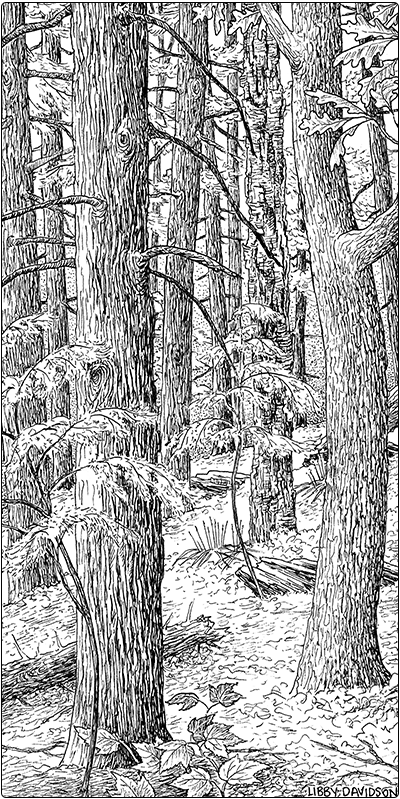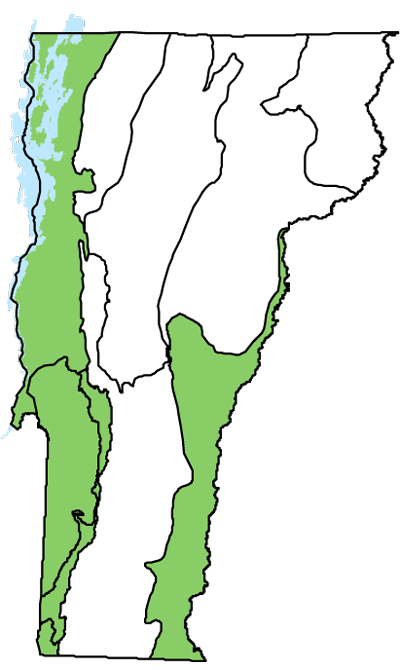Ecology and Physical Setting
Dry Transition Hemlock Forests are found in warmer climate settings. Unlike more northern Hemlock Forests, which can feel cool and moist in summer, these forests feel hot and dry even beneath a closed canopy. The topography is rugged but usually compact. Even a short hike through a Dry Transition Hemlock Forest often involves cresting many low bedrock ridges, each rising steeply above a narrow valley that may be less than 100 feet below. Soils are typically till-derived, acidic, and often well-drained and shallow to bedrock. Like other softwood forests, the soils often feature a clearly-defined, ashy-white albic horizon. This layer results from the leaching of minerals downward through the soil by organic acids that are released during needle decomposition.
Vegetation
Eastern hemlock is the dominant canopy species (75 to 100 percent cover). Some combination of southern species, such as white oak, chestnut oak, and black birch, is always present. On the driest ridges, trees can be somewhat stunted. Red oak and beech are also common associates. Trees more typical of cooler settings, such as yellow birch, sugar maple, and red spruce, are absent. Regeneration of hemlock, oak, and birch is often limited to small gaps. Maple-leaved viburnum, witch hazel, and low sweet blueberry are often present in the understory. Wintergreen, Indian pipes, wild cucumber, bracken fern, and rough leaf rice-grass are common herbs. The shrub and herb layers are sparse due to the dense canopy cover.
Wildlife Habitat
Dense hemlock cover is important winter shelter for white-tailed deer in heavy snow years. The evergreen canopy holds much of the snow as it falls, resulting in shallower snow depths on the protected forest floor, which allows deer to conserve energy. The mast-producing oaks in this community provide an important food source for deer, turkey, and many other birds and mammals. The rugged, rocky terrain of these hemlock forests provides cover and denning sites for porcupines and bobcat. Porcupines are excellent tree climbers and can often be found high in trees eating acorns or clipping off hemlock branch tips, eating the buds, and leaving a carpet of discarded hemlock branches scattered on the forest floor. These conifer forests are prime nesting habitat for Blackburnian warblers and red-breasted nuthatches.
Successional Trends
Hemlock is shade tolerant and regenerates well beneath a dense canopy. Downed “nurse logs” are good germination sites for hemlock and also black birch. Tip-up mounds and the soil disturbance that result from windthrow may play important roles in maintaining oaks in the canopy. Oaks germinate best in loose, nearly bare mineral soil. Black birch is an early successional species (as well as part of the mature forest) and may be dominant in larger openings created by wind or forest management.
Related Communities
- Hemlock Forest is found in cooler settings and lacks the more southern species such as white oak, chestnut oak, and black birch.
- Dry Hemlock-Oak Forest is similar in species composition but has considerably more oaks, black birch, and beech, with less than 75 percent cover of hemlock.
- Sand-Over-Clay Forest can have hemlock, oaks, and black birch in the canopy, but is found on glaciolacustrine deposits in the Champlain Valley. Understory herbs like cinnamon fern and lady fern reflect a fluctuating water table, in contrast to the dry ground conditions in Dry Transition Hemlock Forests.
Conservation Status and Management Considerations
There are several high-quality examples of Dry Transition Hemlock Forest on publicly conserved lands. All known examples of this community have a history of timber harvest, although small old forest examples might remain in remote settings. Hemlock woolly adelgid, an invasive insect, is slowly spreading north into Vermont and may eventually result in significant hemlock mortality. Any forest management should seek to maintain the health and resilience of the hemlocks in this community.
Distribution/Abundance
This community is found in the warmer and drier regions of Vermont. Its best expression is in the Taconic Mountains and Southern Vermont Piedmont. Similar communities can be found throughout southern New England.
Characteristic Plants
Trees
Abundant Species
Eastern hemlock – Tsuga canadensis
Occasional Species
White oak – Quercus alba
Black birch – Betula lenta
Red oak – Quercus rubra
Chestnut oak – Quercus montana
American beech – Fagus grandifolia
White pine – Pinus strobus
Shrubs
Occasional Species
Maple-leaved viburnum – Viburnum acerifolium
Witch hazel – Hamamelis virginiana
Low sweet blueberry – Vaccinium angustifolium
Black huckleberry – Gaylussacia baccata
Herbs
Occasional Species
Bracken fern – Pteridium aquilinum
Rough leaf rice-grass – Oryzopsis asperifolia
Pink lady’s slipper – Cypripedium acaule
Canada mayflower – Maianthemum canadense
Marginal wood fern – Dryopteris marginalis
Rare and Uncommon Plants
Pignut hickory – Carya glabra
Spotted wintergreen – Chimaphila maculata
Associated Animals
Red squirrel – Tamiasciurus hudsonicus
Porcupine – Erethizon dorsatum
Bobcat – Lynx rufus
White-tailed deer – Odocoileus virginianus
Red-breasted nuthatch – Sitta canadensis
Blackburnian warbler – Setophaga fusca
Black-throated green warbler – Setophaga virens
Rare and Uncommon Animals
Eastern ratsnake – Pantherophis alleghaniensis
Timber rattlesnake – Crotalus horridus
Places to Visit
Pond Woods Wildlife Management Area, Benson and Orwell, Vermont Fish and Wildlife Department (VFWD)
Bomoseen State Park, Fair Haven, Benson, Castleton, and Hubbardton, Vermont, Vermont Department of Forests, Parks, and Recreation
Roaring Brook Wildlife Management Area, Vernon, VFWD
